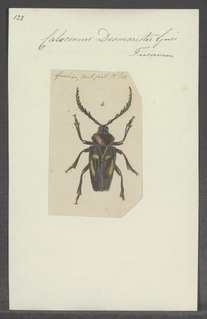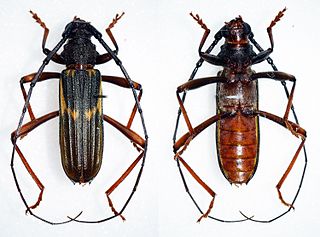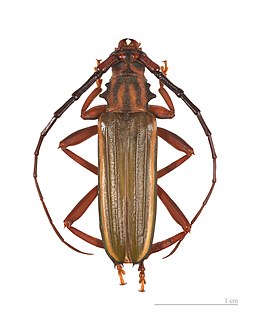
Orthomegas is a genus of beetles in the family Cerambycidae, containing the following species:

Calocomus is a genus of longohrn beetles in the family Cerambycidae, containing the following species:

Bothriospilini is a tribe of beetles in the subfamily Cerambycinae. The tribe was proposed in 1950 by Brazilian entomologist Frederico Lane as a member of the new subfamily Bothriospilinae, and with Bothriospila assigned as the type genus. The tribe is morphologically close to the tribe Torneutini, with which it has in common the same shape of the last abdominal segment, which is wide and largely braided in the female, as well as the anterior thigh cavities that are open from behind and the laterally open medial cavity.
Ochrodion is a genus of beetles in the family Cerambycidae, containing the following species:

Xestiodion is a genus of beetles in the family Cerambycidae, containing the following species:
Anoplomerus is a genus of beetles in the family Cerambycidae, containing the following species:

Chrysoprasis is a genus of beetles in the family Cerambycidae, containing the following species:
Eriphosoma is a genus of beetles in the family Cerambycidae, containing the following species:
Erythrochiton is a genus of beetles in the family Cerambycidae, containing the following species:
Homogenes is a genus of beetles in the family Cerambycidae, containing the following species:
Coremia is a genus of beetles in the family Cerambycidae, containing the following species:
Aegoidus is a genus of beetles in the family Cerambycidae, containing the following species:

Ceragenia is a genus of beetles in the family Cerambycidae, containing the following species:
Unxia is a genus of beetles in the family Cerambycidae, containing the following species:

Cyrtotrachelus is a genus of beetles belonging to the family Curculionidae.

Chlorida cincta is a species of beetle in the family Cerambycidae. It was described by Félix Édouard Guérin-Méneville in 1844. It is known from Mexico, Colombia, and Ecuador.

Chlorida festiva is a species of beetle in the family Cerambycidae. It was described by Carl Linnaeus in his landmark 1758 10th edition of Systema Naturae. It is known from southeastern United States, Central America, South America, and the West Indies. Adult males produce (6E,8Z)-6,8-pentadecadienal, an attractant pheromone. In Puerto Rico the larvae are known to be leaf mining pests of mango crops.
Chlorida spinosa is a species of beetle in the family Cerambycidae. It was described by Per Olof Christopher Aurivillius in 1887. It is known from Colombia, Bolivia and Peru. Adult males produce (6E,8Z)-6,8-pentadecadienal, an attractant pheromone.
Chlorida transversalis is a species of beetle in the family Cerambycidae. It was described by Jean Baptiste Lucien Buquet in 1844. It is known from Colombia.
Entelopes glauca is a species of beetle in the family Cerambycidae. It was described by Félix Édouard Guérin-Méneville in 1844. It is known to be found in Malaysia, Sumatra, Java and Borneo.








